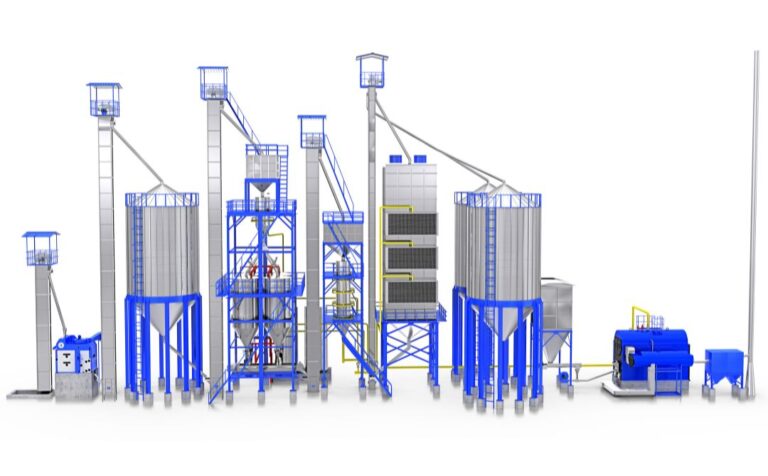Table of Contents
India’s rice industry, a vital lifeline for millions of farmers and consumers, thrives on innovative processing techniques that enhance grain quality and nutritional value. With over 120 million tonnes of paddy produced annually, the full-boiled rice process, particularly through hot water parboiling, has emerged as a cornerstone for producing premium rice that meets both domestic and export demands.
At SKF Elixer, we empower rice millers with state-of-the-art hot water parboiling plants, designed to deliver superior rice quality with efficiency and sustainability tailored for India’s diverse agricultural landscape.
This blog dives into the hot water parboiling process, exploring its steps, benefits, and why it’s a game-changer for rice manufacturers. Whether you’re a miller in Odisha, a cooperative leader in Kerala, or an entrepreneur in Bihar, our insights will guide you toward leveraging this technology for better rice production and profitability.
The Significance of Parboiling in India’s Rice Industry
Rice is a staple for over 70% of India’s population, contributing to a ₹5 lakh crore industry and ₹50,000 crore in exports annually. The full-boiled rice process, involving hot water parboiling, enhances grain strength, nutritional value, and market appeal, making it a preferred choice for 60% of India’s rice consumption.
Traditional methods, like cold water soaking, often result in 3–5% grain losses (150–250 kilograms per 5 tonnes, worth ₹7,500–₹12,500 at ₹50 per kilogram) due to inconsistent gelatinization. Hot water parboiling, by contrast, achieves 95–97% head rice recovery, boosting revenue by ₹20,000–₹30,000 per 10 tonnes.
SKF Elixer’s hot water parboiling plants, equipped with advanced hot water parboiling technology, ensure compliance with Food Safety and Standards Authority of India (FSSAI) standards, delivering high-quality rice that meets consumer and export needs.
Overview of the Hot Water Parboiling Process
Hot water parboiling involves soaking paddy in water heated to 70–85°C, followed by tempering and drying, to gelatinize starch and drive nutrients from the bran into the endosperm. This full-boiled rice process produces translucent, amber-colored rice with enhanced nutritional value, firmer texture, and a shelf life extended by 6–12 months.
Unlike cold water parboiling, which takes 24–48 hours and risks nutrient leaching, hot water parboiling completes soaking in 1–3 hours, reducing water usage by 50% and energy costs by ₹10,000–₹15,000 per 10-tonne batch.
SKF Elixer’s plants automate this process with stainless steel tanks and IoT-enabled controls, ensuring precision and efficiency for rice millers.
Step-by-Step Explanation of Soaking and Steaming
The hot water parboiling process is systematic and optimized for quality:
1. Pre-Cleaning
Paddy is cleaned using vibrating sieves to remove impurities (1–2 kilograms per tonne), such as stones and husk, ensuring hygiene and preventing equipment damage. For a 10-tonne batch, this saves ₹5,000–₹10,000 in grain losses.
2. Hot Water Soaking of Paddy
Paddy is soaked in hot water at 70–85°C for 1–3 hours in stainless steel tanks with a paddy-to-water ratio of 1:1.5–2. This achieves 30–35% moisture content, gelatinizing 70–80% of starch. SKF Elixer’s systems use recirculating pumps to maintain temperature, reducing water usage by 20% and energy costs by ₹10,000–₹15,000 per 10-tonne batch compared to traditional methods.
3. Tempering
Soaked paddy is drained and tempered at 25–30°C for 1–2 hours, allowing even moisture distribution to prevent cracking. This ensures 95–97% head rice recovery, adding ₹20,000–₹30,000 per 10 tonnes in value.
4. Drying
Paddy is dried to 12–14% moisture using hot air dryers (40–50°C) in 6–8 hours for a 5-tonne batch. This prevents spoilage, saving ₹20,000–₹30,000 per batch compared to sun-drying’s 5–10% losses.
5. Milling
Dried paddy is milled to remove husk and bran, producing polished rice with minimal breakage, increasing market value by ₹5–10 per kilogram.
Difference Between Hot Water and Cold Water Parboiling
- Hot Water Parboiling: Soaks paddy at 70–85°C for 1–3 hours, achieving faster gelatinization and retaining 80–90% of nutrients like thiamine (0.4–0.6 mg/100g). It uses 50% less water, saving ₹10,000–₹15,000 per 10-tonne batch, and reduces processing time to 1–2 days.
- Cold Water Parboiling: Soaks paddy at ambient temperature (25–30°C) for 24–48 hours, risking nutrient leaching (30–40% loss) and causing 3–5% grain breakage, costing ₹7,500–₹12,500 per 5 tonnes. It generates more wastewater, increasing environmental costs.
SKF Elixer’s hot water systems offer superior efficiency and quality, ideal for modern rice mills.
Benefits of Hot Water Parboiling for Rice Quality
Hot water parboiling enhances rice quality in several ways:
- Nutritional Value of Hot Water Parboiled Rice: Retains 80–90% of thiamine, iron (2–3 mg/100g), and magnesium (20–30 mg/100g), reducing deficiency risks and healthcare costs by ₹2,000–₹5,000 annually for a family consuming 10 kilograms monthly.
- Higher Milling Yield: Achieves 95–97% head rice recovery, adding ₹20,000–₹30,000 per 10 tonnes in value.
- Improved Texture: Produces firm, non-sticky grains, ideal for premium dishes, increasing market value by ₹5–10 per kilogram.
- Pest Resistance: Extends shelf life by 6–12 months, saving ₹10,000–₹20,000 per 10 tonnes in storage losses.
- Lower Glycemic Index: GI of 38–50 supports diabetes management, saving ₹3,000–₹5,000 annually in medical costs.
For a 50-tonne-per-day mill, these benefits translate to ₹2–3 crore in additional annual revenue.
Industrial Adoption of Hot Water Parboiling Technology
Hot water parboiling is increasingly adopted by Indian rice mills due to:
- Efficiency: Reduces processing time by 60–70% compared to cold water methods, increasing throughput by 50% for mills.
- Sustainability: Uses 50% less water and 20–30% less energy, saving ₹1–2 lakh annually for a 10-tonne-per-day plant.
- Export Appeal: Meets global standards, boosting parboiled rice exports by ₹50,000 crore annually.
SKF Elixer’s plants, with IoT-enabled controls, enhance adoption by ensuring consistent quality and compliance with FSSAI standards.
Hot Water Parboiling Plant Setup with SKF Elixer
Our plants are tailored for efficiency:
- Small-Scale Mills: 5–10-tonne-per-day plants occupy 100–150 square meters, saving ₹50,000–₹1 lakh annually in labor, ideal for cooperatives in Kerala.
- Large-Scale Mills: 20–50-tonne-per-day systems yield ₹2–3 crore annually in higher output for mills in Odisha.
- Smart Features: Stainless steel tanks and IoT controls reduce energy costs by 20–30%, saving ₹1–2 lakh annually for a 10-tonne-per-day plant.
Subsidies under PM Kisan Sampada Yojana could offset 20–30% of costs, ensuring affordability.
Why Choose SKF Elixer?
With years of expertise, SKF Elixer delivers BIS-certified hot water parboiling plants tailored for India’s rice varieties. Our options, support, and AMCs starting at ₹50,000 per year ensure reliability for rice millers.
Conclusion
The hot water parboiling process transforms rice production, delivering superior quality, nutrition, and profitability. SKF Elixer’s advanced plants make this technology accessible, empowering millers to meet India’s growing demand for premium rice.
Choose our solutions to elevate your operations.
Ready to optimize your rice processing? Contact SKF Elixer to explore our hot water parboiling plants.
FAQs
-
1. What is the overview of the hot water parboiling process?
Hot water parboiling soaks paddy at 70–85°C for 1–3 hours, followed by tempering and drying, achieving 95–97% head rice recovery and retaining 80–90% nutrients, saving ₹20,000–₹30,000 per 10 tonnes.
-
2. What is the step-by-step explanation of soaking and steaming in hot water parboiling?
It includes pre-cleaning (1–2 kg impurities per tonne), soaking (70–85°C, 1–3 hours), tempering (1–2 hours), drying (6–8 hours), and milling, saving ₹20,000–₹30,000 per 10-tonne batch in losses.
-
3. What are the benefits of hot water parboiling for rice quality?
It improves head rice recovery (95–97%), retains thiamine (0.4–0.6 mg/100g), extends shelf life by 6–12 months, and enhances texture, adding ₹20,000–₹30,000 per 10 tonnes in value.
-
4. What is the difference between hot water and cold water parboiling?
Hot water parboiling (1–3 hours, 70–85°C) uses 50% less water, retains 80–90% nutrients, and reduces losses to <2%, saving ₹10,000–₹15,000 per 10 tonnes compared to cold water (24–48 hours).
-
5. How is hot water parboiling technology adopted industrially?
SKF Elixer’s plants, with IoT controls and stainless steel tanks, reduce energy by 20–30% (₹1–2 lakh annually for 10 tonnes/day), meet FSSAI standards, and boost exports by ₹50,000 crore annually.
Good reads are meant to be shared









